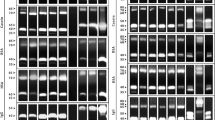Abstract
Candida albicans is one of the most common pathogens of opportunistic infections and has a lot of hydrolytic enzymes important for pathogenesis of candidiasis, such as protease, phospholipase, and others. The genome of C. albicans contains seven phospholipase genes C (pla, plb1 plb2, plc1, plc2, plc3, and pld1), only four of which are well studied and well described (plb1 plb2, plc, and pld1); the role of others in the pathogenesis of candidiasis remains unclear. In this paper, the effect of iron on the hemolytic activity (HA) and gene expression of phospholipase C—plc, plb1, and plb2 by C. albicans in a nutrient broth and serum is studied. It is established that the addition of iron in the broth and serum induces a hemolytic activity and gene expression plb1 and plb2 of phospholipase C by C. albicans. In the serum, the highest dependence on the iron concentration ([Fe2+]) was observed for the expression of the plb2 gene and plc phospholipase C. Comparative characteristics of the presented results showed that in the serum, the expression level of the phospholipase C genes is lower than in the Saburo broth. The highest iron dependence is observed for the plb2 gene. It can be demonstrated according to the research that the nature of the hemolytic activity of C. albicans is due to the expression of the phospholipase gene plb2; the value of other genes in the expression of HA substantially depends on the medium of cultivation. Thus, any changes of iron homeostasis in the direction of an overloaded iron induce the activity of phospholipase C PLB2 and PLС by Candida spp. making iron from hemoglobin available for uptake, which is important for the pathogenesis of candidiasis.
Similar content being viewed by others
References
Mironov, А. Y. U., & Leonov, V. V. (2016). Iron, virulence and intermicrobial interactions of opportunistic pathogens. Biology Bulletin Reviews, 136(3), 301–310.
Meyers, D. J., & Berk, R. S. (1990). Characterization of phospholipase C from Pseudomonas aeruginosa as a potent inflammatory agent. Infection and Immunity, 58, 659–666.
Walker, T. S., Brown, J. S., Hoover, C. S., & Morgan, D. A. (1990). Endothelial prostaglandin secretion: effects of typhus rickettsiae. The Journal of Infectious Diseases, 162(5), 1136–1144.
Vidotto, V., Yumi Koga-Ito, C., Milano, R., Fianchino, B., & Pontón, J. (1999). Correlation between germ tube production, phospholipase activity and serotype distribution in Candida albicans. Revista Iberoamericana de Micología, 16, 208–210.
Tsang, C. S. P., Chu, F. C. S., Leung, W. K., Jin, L. J., Samaranayake, L. P., & Siu, S. C. (2007). Phospholipase, proteinase and haemolytic activities of Candida albicans isolated from oral cavities of patients with type 2 diabetes mellitus. Journal of Medical Microbiology, 56(10), 1393–1398.
Leonov, V. V., Kosterina, V. V., Varnitsina, V. V., Timokhina, T. K., & Kurlovich, N. A. (2012). Iron-dependent synthesis of hemolysins by Staphylococcus aureus. Bulletin of Experimental Biology and Medicine, 153(1), 41–43 Russian.
Ansell, G. B., & Hawthorne, J. N. (1964). Catabolism. In G. B. Ansell & J. N. Hawthorne (Eds.), Phospholipids (pp. 152–174). Amsterdam: Elsevier Publishing Co..
Ghannoum, M. A. (2000). Potential role of phospholipases in virulence and fungal pathogenesis. Clinical Microbiology Reviews, 13, 122–143. https://doi.org/10.1128/CMR.13.1.122-143.2000.
Leonov, V. V., Kurlovich, N. A., Sokolova, T. N., Timokhina, T. K., & Fateeva, N. M. (2013). Iron and hemolytic activity Candida albicans. Problemy medicinskoj mikologii, 15(4), 70–73 Russian.
Samaranayake, Y. H., Dassanayake, R. S., Cheung, B. P. K., Jayatilake, J. A., Yeung, K. W. S., Yau, J. Y. Y., & Samaranayake, L. P. (2006). Differential phospholipase gene expression by Candida albicans in artificial media and cultured human oral epithelium. APMIS, 114(1), 857–866.
Nas, T., Kalkanci, A., Fidan, I., Hizel, K., Bolat, S., Yolbakan, S., Yilmaz, E., Ozkan, S., & Kustimur, S. (2008). Expression of als1, hwp1 and sap4 genes in Candida albicans strains isolated from women with vaginitis. Folia Microbiologica, 53(2), 179–183.
Samaranayake, Y. H., Cheung, B. P. K., Yau, J. Y. Y., Yeung, S. K. W., & Samaranayake, L. P. Human serum promotes Candida albicans biofilm growth and virulence gene expression on silicone biomaterial. PLoS One, 8(5), e62902.
Ermilova EV, Zaluckaja ZhM., Lapina TV, Matveeva TV (2010) Quantitative analysis of gene expression. Tutorial. SPb.: ТЕSSA, 104p. Russian.
Welch, R. A. (1991). Pore-forming cytolysins of gram-negative bacteria. Molecular Microbiology, 5(3), 521–528.
Andreeva-Kovalevskaya, Z. I., Solonin, A. S., Sineva, E. V., & Ternovsky, V. I. (2008). Pore-forming proteins and adaptation of living organisms to environmental conditions. Biochemistry, 73(13), 1473–1492.
Moors, M. A., Stull, T. L., Blank, K. J., Buckley, H. R., & Mosser, D. M. (1992). A role for complement receptor-like molecules in iron acquisition by Candida albicans. The Journal of Experimental Medicine, 175, 1643–1651.
Author information
Authors and Affiliations
Corresponding author
Ethics declarations
Conflict of Interest
The authors declare that they have no conflict of interest.
Rights and permissions
About this article
Cite this article
Leonov, V.V., Mironov, A.Y., Bulatov, I.A. et al. On the Question of the Nature of Hemolytic Activity of Candida albicans . BioNanoSci. 8, 446–449 (2018). https://doi.org/10.1007/s12668-017-0479-y
Published:
Issue Date:
DOI: https://doi.org/10.1007/s12668-017-0479-y




